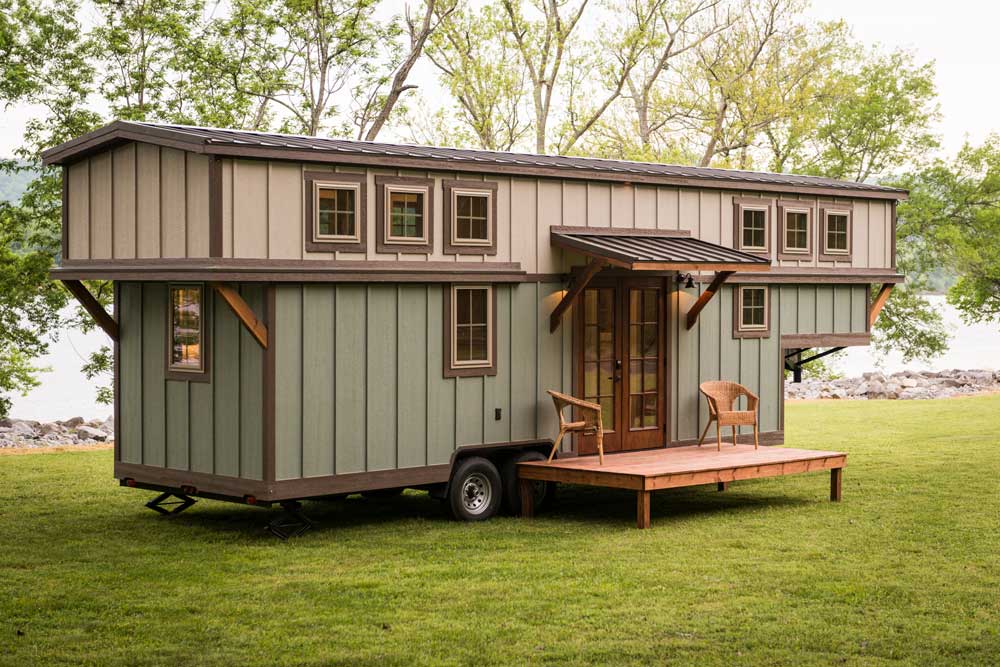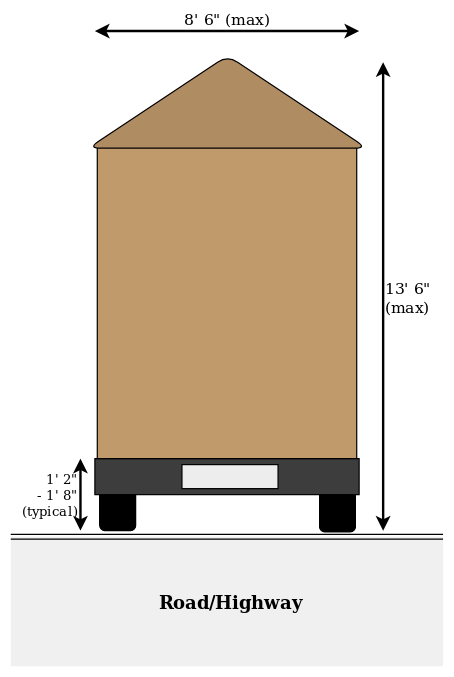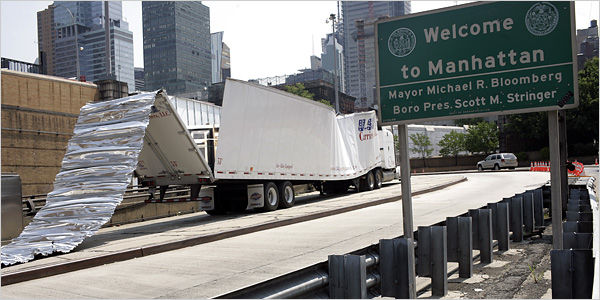Blog

Max Size & Weight For A Tiny House On Wheels Without Permits
When you set about transporting your tiny house on a trailer (often called a THOW) to its new destination, there are various complexities you have to consider and overcome. Due to this, you will want to avoid having to fill in a bunch of paperwork and apply for permits per state, by ensuring that your THOW does not contravene size and weight limits. These limit per state, although there are some common rules which apply for the vast majority of states.
In general, tiny houses cannot be more than 13’ 6” tall, 8’ 6” wide and 40’ long (65’ including the tow vehicle, and 53’ max for the trailer) – before permits are required. Legal weight limits are less stringent, although anything over 16,000 pounds (including the trailer weight) becomes less practical as a more powerful tow truck will be needed.
Maximum Size For THOWs (Without Road Permits)
In theory, pretty much any size of motor vehicle can be transported on public roads and highways – such as when large airplane parts need to be transported from a factory to assembly site:
However you will notice a few things:
- The road is entirely shut: there is no traffic other than the large transport truck(s) and the escorts.
- There are police escorts, who specialize in closing off roads and helping navigation.
And needless to say, this costs a lot of money and it needs planning in advance. Whilst your tiny house will never reach this size, if it breaches certain size limits you will need to apply for permits and this will make the transportation of your house more difficult – and expensive. Hence keeping your THOW within certain size limits – and not needing to apply for road permits – is a big benefit for tiny house owners.
So what are these size limits? Well, the Federal Size Regulations for Commercial Motor Vehicles does not actually apply to RVs or tiny houses but its restrictions on motor vehicles are essentially the same as on tiny houses:
“There is no Federal vehicle height requirement for CMVs. Thus, States may set their own height restrictions. Most height limits range from 13 feet, 6 inches (4.11 meters) to 14 feet (4.27 meters), with exceptions granted for lower clearance on particular roads.” – in other words, the height is not specifically restricted, however there are there are a range of bridges and roads which can be difficult to navigate for vehicles taller than 13’ 6” (or even less – more on this in a later section). And because some states also set this as their maximum point, we would suggest that the total combined height of your trailer plus tiny house does not exceed this.- “The maximum width limit for CMVs on the NN and reasonable access routes was originally established at 102 inches” – before going on to say that this has now been standardized as the metric 2.6 metres, which is 102.4”. Either way, you can reasonbly take 102 inches (i.e. 8’ 6”) as a maximum width for the outside of your tiny house. When designing your tiny house, remember that wall thickness also comes into play, however, so the internal width of your THOW will be a fair bit less than this.
- “The Federal length limits are principally minimums that States must allow for the following vehicles on the NN and reasonable access routes” – the guide goes onto discuss maximum lengths for different types of vehicles, which can also vary per state. This can therefore get a little complicated, but a tiny house longer than 40’ will start to cause issues on some states when transporting it on highways. Fortunately it is rare for THOWs to exceed 30’ (with 20-26’ lengths being most common), let alone exceeding 40’.
Remember that the size of the trailer also needs to be taken into account, especially when it comes to the height. In other words:

Practical Size Limits For Tiny Houses
The above section mainly looks at the maximum dimensions your tiny house on a trailer can be before permits are required in most states, but there are even risks at 13’ 6” heights as a worrying New York Times article covers:

As the article explains, this truck was at the ‘safe legal maximum’ of 13’ 6”, however it did not spot the signs saying that the Lincoln Tunnel has a 13 foot height restriction. They also – somehow – ignored dozens of warnings and flashing lights showing them that they should not be in the tunnel, and as a result they lost their roof.
Unfortunately sat navs are not great at telling people when their route takes them through a restricted-height tunnel or bridge, so always be careful if your THOW is more than 13’ tall. Some tiny house owners have found that 13’ 4” or below is a bit safer, due to a few bridges and tunnels which are just a bit too small for 13’ 6” vehicles. Plus if you aim for 13’ 4” and hit an uneven road surface, you could find that part of your THOW comes close to 13’ 6”: having that extra overhead (literally) in your height can be useful,
On the topic of bridges, a common design – especially on older bridges – is an arch bridge. These are tallest in the center, but the height drops off a lot at the edges:

These bridges can be easier to build and give a good amount of structural strength due to their design, but be very cautious of them when transporting your tiny house. You may have to drive in the middle of the road, as driving in your lane might see part of your roof hit the bridge arch.
Minimum and Maximum Weight For Tiny Houses (Without Road Permits)
The maximum road weight for tiny houses (without needing permits) is a bit like the maximum length – higher than most tiny houses will hit. Indeed, the legal maximum weights are frequently over 20,000 pounds, whilst a typical 20’ long tiny house will barely hit 10,000 pounds even with possessions in it (unless you are a hoarder, in which case the tiny house lifestyle might not suit you!). A general rule of thumb is that a tiny house weighs around 500 pounds for every 1’ of length.
The main thing that you need to be wary of is if your tiny house weight (including possessions and the ~2,000 trailer weight, of course) exceeds the towing capacity of your tow rig. For example the 2019 Silverado 2500HD can tow 15,400 pounds (6,985 kg) with the largest engine configuration, or around 14,000 pounds with the typical model. So if your tiny house is coming close to this weight, you might need to reduce your overall weight or look at hiring out a more powerful tow truck. For example the Ford F-450 Super Duty is an absolute beast, with a towing capacity of 32,500 pounds with the latest V8 turbo diesel engine.
Conversely to this, however, your tiny house should not be too light, either! Your tiny house will be hit by some large winds when moving it on the highway so it should be weighted and tied down sufficiently. This is not an issue for lived-in tiny houses, but if you were looking to transport a partially built tiny house shell, be sure that it is properly fixed to the trailer when transporting it. This is especially true if there are poor weather conditions when you hit the road.
Tiny House Trailer Weight
There are three weights to be mindful of when it comes to the trailer you will use to move your tiny house:
- The gross vehicle weight rating (GVWR).
- The trailer’s actual weight.
- The tongue weight.
The all-important GVWR is how much the trailer can safely hold, meaning what is on top of the trailer (i.e. the tiny house and the possessions inside it) but also the weight of the trailer. Most ‘tiny house’ trailers’ GVWR will far exceed the typical weight of a standard tiny house, but be sure to double check this – especially if you are buying an older trailer.
The trailer’s actual weight is then important because – as touched on earlier – if your tiny house weighs 14,500 pounds by itself and the trailer weighs 2,000 pounds, you will almost certainly exceed the towing capacity of a standard pickup truck. It is easy to forget the trailer weight, but it must be included in your overall weight calculations.
Tongue weight is essential when towing any trailer: it is the downforce from the trailer’s tongue to the towing hitch, and if it is incorrect then towing can become unstable and make driving harder (or even unsafe). This should be a percentage of the overall GVW (gross vehicle weight), also called the GTW (gross trailer weight) – and is usually 5-10% for a tiny house trailer.